Compatibility and installation
The new Zalman CNPS9900DF is a universal
cooler in the full meaning of this word It is compatible with most processors
and platforms out there with no exceptions.

Compatibility
of the device
Installation process is similar for all
platforms and starts by mounting the steel brackets to the base of the cooler:
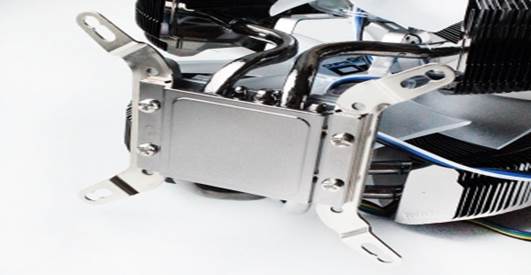
Mounting
This photograph shows the retention bracket
for the Intel platform. If you intend to install this cooler for AMD platform,
you will have to use a different set of straight brackets.
Then, apply a layer of thermal paste on the
CPU, install the cooler on it and tighten the Allen screws (with hex-shaped
sockets) with the particular L-shaped wrench:
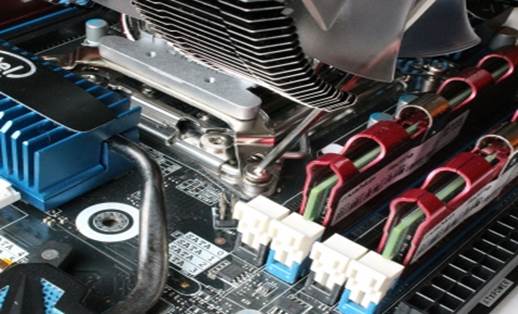
Installing
the device into CPU
Actually there is a little bit difficult to
complete the final step. Firstly, it is challenging to put the screws into the
holes of the brackets when tightened. On top of the, the L-wrench inserted into
the screw sockets at an angle doesn’t seem to go in, while later you can barely
get it out of the socket at all. Nevertheless, 10-15 minutes later the screws
are in place and have been perfectly tightened, the cooling device is secure in
the motherboard and the processor.
For the cooler compatibility with tall
memory module heat-spreaders and other heatsinks around the processor's socket,
we can’t state definitively that Zalman CNPS9900DF will not occur any conflict,
because its lowest heatsink fins are only 30 mm above the mainboard surface:
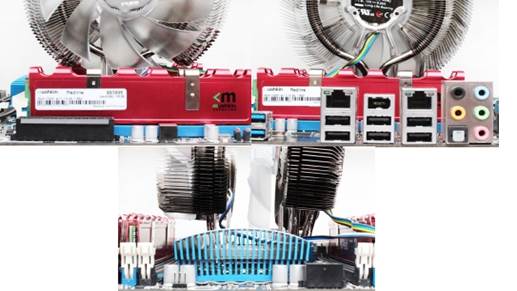
The
complete installation process
However, the lower part of the heatsink is
a little tight, which is why it would conflict with memory module featuring a
tall heatsink installed near the DIMM slots of the processor.
The manual recommend installing the Zalman
CNPS9900DF cooler in the following way:

Install
the Zalman CNPS9900DF follow the Manual
In addition, we also tested Zalman
CNPS9900DF in an alternative direction, such as turning a 90-degree angle:
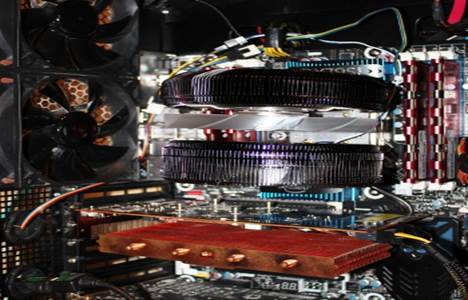
Installing
angle of 90 degrees
Note that we did not record any differences
between those installations. And what particular level of efficiency we are
talking about? Let's dig a little deeper!
Configuration and testing methodology
We've tested the whole cooling device in a
closed system case with the following configurations:
·
Motherboard: Intel Sliler DX79SI (Intel X79
Express, LGA 2011, BIOS 0537)
·
CPU: Intel Core i7-3960X Extreme Edition, 3.3
GHz, 1.2 V, 6x256 KB L2, 15 MB L3 (Sandy Bridge-E, C1, 32 nm)
·
Surface: ARCTIC MX-4
·
Graphic card: AMD Radeon HD 7770 1 GB GDDR5 128
bit, 1,000/4,500 MHz
·
System Memory: DDR3 4x4GB Mushkin Redline (Spec:
2,133 MHz/ 9-11-10-28/ 1.65 V)
·
System hard drive: Crucial m4 256 GB SSD
·
Drive for programs and games: Western Digital
VelociRaptor (300GB, SATA-II, 10,000 RPM, 16MB cache, NCQ) inside Scythe Quiet
Drive 3.5’’ HDD silencer and cooler
·
Back up drive: Samsung Ecogreen F4 HD204UI
?(SATA-II, 2 TB, 5400 RPM, 32 MB, NCQ)
·
Case: Antec Twelvw Hundred (the front: 3
Noiseblocker NB-Multiframe S-Series MF 12-S2 fans (1020 RPM); the back: 2
Noiseblocker NB-BlackSilent PRO PL-1 fans (1,020 RPM); the top: 200 mm standard
fan (400 RPM)
·
Control panel: Zalman ZM-MFC3
·
Power: Seasonic SS-1000XP Active PFC F13 1,000 W
(with 120 mm standard fan)
Preparing for the
primary test and summary diagram, we've overclocked our 6-core processor with
the clock generator frequency set at 125 Mhz, the multiplier at 34x and
“Load-Line Calibration” enabled to 4.25 GHz. The nominal Vcore of the
processor is increased to 1.35 V in the mainboard BIOS. The "Turbo
Boost" technology was disabled during this testing process, and the
Hyper-Threading technology was enabled to increase heat dissipation. The memory
voltage was at 1.65 V and its frequency is 2,000 MHz with timing parameters are
9-11-10-28 parameters. All other configurations are available in the mainboard
BIOS and related to the overclocking process of the CPU or memory remained
unchanged.
All tests were conducted under Windows 7
Ultimate x64 SP1 operating system. We used the following software in the
experiment:
The process used during our testing
process:
·
Linx AVX Edition version 0.6.4 - to open the
processor (memory - 4,500 MB, Problem Size - 24,234, 2 rounds with 11 minutes
for each round)
·
Real Temp GT version 3.70 - to control the temperature
of the processor
·
Intel Extreme Tuning Utility version 3.1.201.5 -
to control and observe the parameters of the system during overclocking section
Thus, a complete
picture of the testing process looks like this:
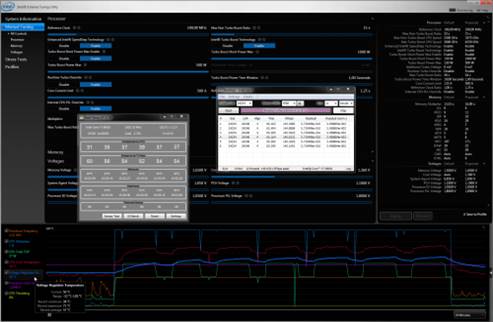
Complete
picture the testing process
The CPU was loaded with two consecutive
LinX AVX test runs with the settings as indicated above. The stabilization
period for the CPU temperature between the two test cycles was about 8-10
minutes. We took the highest temperature of the CPU core for the results chart.
Moreover, we also offered a table with temperature parameters for all cores
including their average values. The ambient temperature was checked next to the
system case with an electronic thermometer with 0.1°C precision that allows hourly
monitoring of the temperature changes during the past 6 hours. The room
temperature during our experiment varied between 24.0 and 24.1°C.
The noise level of the cooling device was
measured between 1:00 and 3:00 AM in a big closed room about 20 m2
by using CENTER-321 electronic noise meter. The noise level of each cooler was
tested outside the system case when the only noise sources in the lab were the
cooler and its fan. The noise meter was mounted on a tripod and 150mm away from
the fan impeller. The examined cooling system was placed at the edge of the
table on a sheet of polyurethane foam. The lowest noise parameter that our
noise meter can read is 29.8 dBA and the subjectively comfortable noise level
in these testing conditions was around 36 dBA (do not mix it up with low noise
level). The rotational speed of the rotor was adjusted in entire supported
range of in-house controller by changing the voltage with 0.5 V increment.

Voltage
controlling device
We will compare the cooling efficiency and
noise level of the Zalman CNPS9900DF with the Thermalright Spirit 140 with a
TY-140 default fan in two operation mode - when running at full speed and at
static mode with 800 RPM:

Thermalright
Spirit 140
The rotational speed of all fans was
controlled by using a special controler similar to which I mentioned above with
a ± 10 RPM precision.